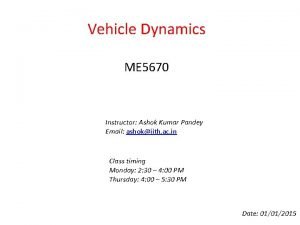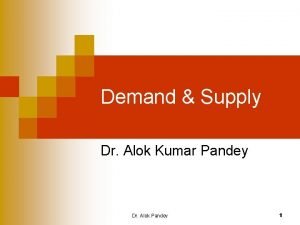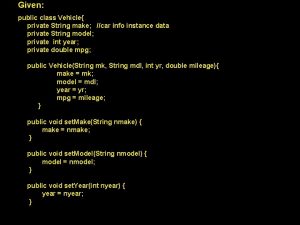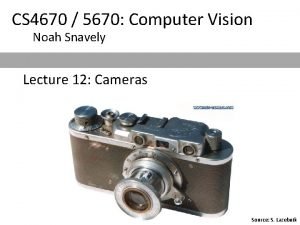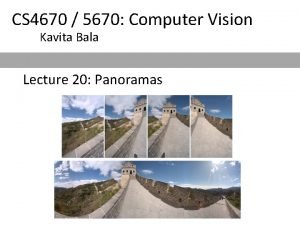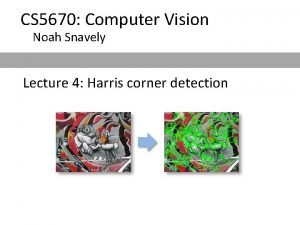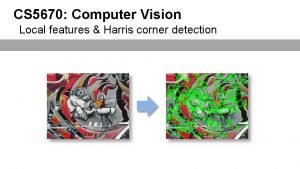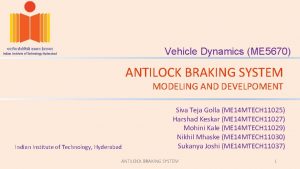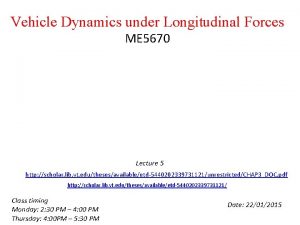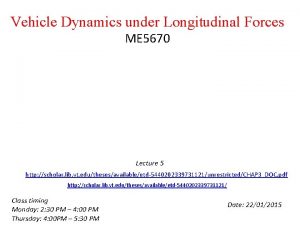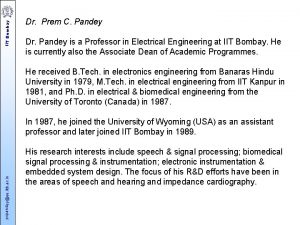Vehicle Dynamics ME 5670 Instructor Ashok Kumar Pandey






- Slides: 6

Vehicle Dynamics ME 5670 Instructor: Ashok Kumar Pandey Email: ashok@iith. ac. in Class timing Monday: 2: 30 – 4: 00 PM Thursday: 4: 00 – 5: 30 PM Date: 01/01/2015

Fundamental Definitions Vehicle Dynamics It concerns with the movements of vehicles on a road surface Physical condition Acceleration and braking, ride, and turning Dynamic behavior Forces on the vehicle due to tires, gravity, and aerodynamics. Vehicle and its components are studied to determine forces produced by the sources at particular maneuver and trim condition Objective How the vehicle responds to these forces. Representation One mass approximation Located at its C. G. For acceleration, braking, and most turning analysis. Two masses approximation For ride analysis, wheels are treated as separate lumped masses Body mass as sprung mass. Wheel mass as unsprung mass.

Vehicle Dynamics Interaction Vehicle dynamics Isolation It implies the rejection of disturbance Separating driver from the disturbances Internally generated disturbance Control Engine vibration and noise Externally generated disturbance Aerodynamic interaction (crosswinds, wakes, etc) Road undulation Forces/effects Absence of disturbance amplification Path Speed Stability Agility Fidelity Linearity Vertical Longitudinal Lateral Refinement Ride Subjective Handling Objective Performance

Course Content • Vehicle Mechanics – Forces under static and dynamic equilibrium. • Free body diagram of different vehicle components such as tire, braking, suspension, chassis, car body, gear box, clutch system, power steering, chassis, car body. • Simple linearized rigid models of different components. • Dynamic stability and the vehicle performance under different operating conditions such as - understeering, neutralsteering, oversteering, and - factors associated with the vehicle-terrain interaction. • Concept of vehicle ride comfort. • Introduction to random excitation and electronics stability controls. • Performance characteristics of a comfort vehicle ride. • Introduction to the development of one-dimensional vehicle driveline using different softwares such as MATLAB Simulink/ADAMS/Carsim. • Introduction to advanced topics in the accurate modelling of vehicle dynamics – Nonlinear models considering large deformation and material nonlinearity.

Grading Scheme • Attendence: 10% • Assignments: 15% • Mid Term: 30% • Project report: 15% • Final Term: 30% <hr class="fgc"> <a href="VD/Mid_Sem. pdf"> I. Mid-Term Problems (01/03/2014)</a> <hr class="fgc"> <a href="VD/Solution_Mid_Term. mp 4">II. Solution to Mid-term Problems (Voice is properly audible after 20 mins. and 20 sec. )(01/03/2014)</a> <hr class="fgc"> <a href="VD/Lecture 2. mp 4">III. Lecture video: Equation of Motion on Turning : Linearized Form (11/03/2014)</a> <hr class="fgc">

References 1. Thomas Gillespie, “Fundamentals of Vehicle Dynamics”, SAE, 1992. 2. Dean Karnopp, “Vehicle Dynamics, Stability, and Control”, Second Edition, CRC Press, 2013. 3. Giancarlo Genta, “Motor Vehicle Dynamics-Modeling and Simulation”, World Scientific, 2013 3. Giancarlo Genta and Lorenzo Morello, “The Automotive Chasis- Volume 1 and 2”, Springer, 2009. 4. John C. Dixon, “Tires, Suspension and Handling”, SAE, 1996. Herb Adams, “Chassis Engineering: Chassis Design, Building & Tuning for High Performance Handling, Brownian Dynamics”, HP Trade, 1992 Softwares: Carsim, Bike. SIm, ADAMS, SYSTEM MODELER/MAPLESIM, MATLAB SIMULINK, SOLID EDGE/UNIGRAPHICS,
